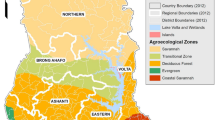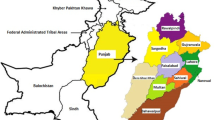Abstract
Fifty-one maize samples, intended for animal feed and human consumption, were collected from the four main maize production provinces in Iran and analyzed by high-performance liquid chromatography (HPLC) for contamination by four naturally occurring aflatoxin analogues (AFB1, AFB2, AFG1, and AFG2). AFB1 was detected in 58.3, and 80% of the maize samples obtained from Kermanshah and Mazandaran provinces, respectively. The maximum AFB1 (276.3 μg/kg) and highest level of total aflatoxins (AFT) (316.9 μg/kg) were detected in a maize sample collected from Kermanshah province. The mean aflatoxin level from contaminated samples (52.60 μg/kg) from Kermanshah was significantly higher (P < 0.0001) than those in maize from the other three provinces and exceeded all the maximum tolerated levels (MTLs) set for AFT in maize. The level of AFB1 in 15.68% of the total samples was above the MTL (5 μg/kg) for AFB1 in maize in Iran. The mean contamination level of AFT (23.86 μg/kg) in the positive samples was higher than MTL for maize in Iran (20 μg/kg) intended for animal feed. The levels of AFB1, AFB2, AFG1, and AFG2 ranged between not detected (<0.1 μg/kg) and 276.3, 30.4, 9.1, and 1.1 μg/kg in maize grain, respectively.

Similar content being viewed by others
References
International Agency for Research on Cancer. In: IARC monographs on evaluation of carcinogenic risk to humans. Some naturally occurring substances: food items and constituents. France: IARC; 1993. No. 56.
JECFA, Forty-ninth meeting of the joint FAO/WHO expert committee on food additives, safety evaluation of certain food additives and contaminants: Aflatoxins, WHO food additives. Geneva: WHO; 1998. Series 40.
Razzaghi-Abyaneh M, Shams-Ghahfarokhi M, Allameh A, Kazeroon-Shiri A, Ranjbar-Bahadori S, Mirzahoseini H, et al. A survey on distribution of Aspergillus section flavi in corn field soils in Iran: population patterns based on aflatoxins, cyclopiazonic acid and sclerotia production. Mycopathologia. 2006;161:183–92.
Lacey J. The microbiology of cereal grains from area of Iran with a high incidence of esophageal cancer. J Stored Prod Res. 1998;24:39–50.
Ghiasian SA, Rezayat SM, Kord-Bacheh P, Maghsood AH, Yazdanpanah H, Shephard GS, et al. Fumonisin production by Fusarium species isolated from freshly harvested corn in Iran. Mycopathologia. 2005;159:31–40.
Ghiasian SA, Kord-Bacheh P, Rezayat SM, Maghsood AH, Taherkhani H. Mycoflora of Iranian maize harvested in the main production areas in 2000. Mycopathologia. 2004;158:113–21.
Ghiasian SA, Maghsood AH, Yazdanpanah H, Shephard GS, Van Der Westhuizen L, Vismer HF, et al. Incidence of Fusarium verticillioides and levels of fumonisins in corn from main production areas in Iran. J Agric Food Chem. 2006;54:6118–22.
Yazdanpanah H, Shephard GS, Marasas WFO, Van der Westhuizen L, Rahimian H, Safavi SN, et al. Human dietary exposure to fumonisin B1 from Iranian maize harvested during 1998–2000. Mycopathologia. 2006;161:395–401.
Hadiani MR, Yazdanpanah H, Ghazi Khansari M, Cheraghali AM, Goodarzi M. Survey of the natural occurrence of zearalenone in maize from northern Iran by thin-layer chromatography densitometry. Food Addit Contam. 2003;20:380–5.
Yazdanpanah H, Miraglia M, Calfapietra FR, Brera C. Natural occurrence of aflatoxins and ochratoxin a in corn and barley from mazandaran and golestan in north provinces of Iran. Mycotoxin Res. 2001;17:21–30.
Ghiasian SA, Aghamirian MR, Maghsood AH, Shephard GS, van der Westhuizen L. Occurrence of fumonisins in maize imported into Iran during 2001–2002. Mycotoxin Res. 2009;25:25–8.
Gelderblom WCA, Rheeder JP, Leggott N, Stockenström S, Humphreys J, Shephard GS, et al. Fumonisin contamination of a corn sample associated with the induction of hepatocarcinogenesis in rats-role of dietary deficiencies. Food Chem Toxicol. 2004;42:471–9.
Pitt JI, Hocking AD. Fungi and food spoilage. 2nd ed. Gaithersburg: Aspen Publishers; 1999. p. 593.
Raper KB, Fennell DJ. The genus Aspergillus. Baltimore: Williams and Wilkins; 1965.
Institute of Standard and Industrial Research of I. R. In: ISIRI, maximum tolerated limits of mycotoxins in foods and feeds. Iran, National standard no. 5925; 2002.
Farombi EO. Aflatoxin contamination of foods in developing countries: implications for hepatocellular carcinoma and chemopreventive strategies. Afr J Biotechnol. 2006;5:1–14.
Tayebi J, Esavi C. Investigation on Aflatoxins B and G contamination in corn in the field. In: Proceedings of the 13th Iran plant protection congress; 1998. p. 92.
Hormozdiari H, Day NE, Aramesh B, Mahboubi E. Dietary factors and esophageal cancer in the caspian littoral of Iran. Cancer Res. 1975;35:3493–8.
Ngoko Z, Shephard GS, Wingfield MJ, Cardwell KF. Fungal infection and mycotoxin contamination of maize in humid forest and western highlands of Cameroon. Phytoparasitica. 2001;29:352–60.
FDA (U. S. Food and Drug Administration). Adulterated food. Federal food drug and cosmetic act, chapter IV: Definitions and standards for food, sec 402(a) (1); 1997. http://www.fda.gov/opacom/laws/fdcact/fdcact4.htm. Accessed 30 June 2009.
Corry JEL. Relationship of water activity to fungal growth. In: Beuchat LR, editor. Food and beverage mycology, Avi book. N Y: Van Nostrand Reinhold; 1987. p. 51–99.
Steyn PS. Mycotoxins, general view, chemistry and structure. Toxicol Lett. 1995;82:843–54.
CAST (Council for Agricultural Science and Technology). Mycotoxins: risk in plant, animal and human systems. Ames: ACS Publications; 2003. p. 105.
Rodricks JV, Stoloff L. Aflatoxin residues from contaminated feed in edible tissues of food-producing animals. In: Rodricks JV, Hesseltine CW, Mehlman MA, editors. Mycotoxins and animal health. Illinois: Pathotox; 1977. p. 67–79.
Ghiasian SA, Maghsood AH, Neyestani TR, Mirhendi SH. Occurrence of aflatoxin M1 in raw milk during the summer and winter seasons in Hamedan, Iran. J Food Saf. 2007;27:188–98.
Alborzi S, Pouzbbzs B, Rashidi M, Astaneh B. Aflatoxin M1 contamination in pasteurized milk in Shiraz (south of Iran). Food Control. 2006;17:582–4.
Chamberlain WJ, Bacon CW, Norred WP, Voss KA. Levels of fumonisin B1 in corn naturally contaminated with aflatoxins. Food Chem Toxicol. 1993;31:995–8.
Acknowledgments
The authors extend their sincere gratitude to K. Zabihi (Herbal Forage of Ministry of Agriculture, Tehran, Iran) for providing facilities for the collection of maize and A. Roohbakhsh for preparation of meteorological data. We are also grateful to the PROMEC Unit, Medical Research Council, South Africa for its technical support.
Author information
Authors and Affiliations
Corresponding author
Rights and permissions
About this article
Cite this article
Ghiasian, S.A., Shephard, G.S. & Yazdanpanah, H. Natural Occurrence of Aflatoxins from Maize in Iran. Mycopathologia 172, 153–160 (2011). https://doi.org/10.1007/s11046-011-9405-y
Received:
Accepted:
Published:
Issue Date:
DOI: https://doi.org/10.1007/s11046-011-9405-y




